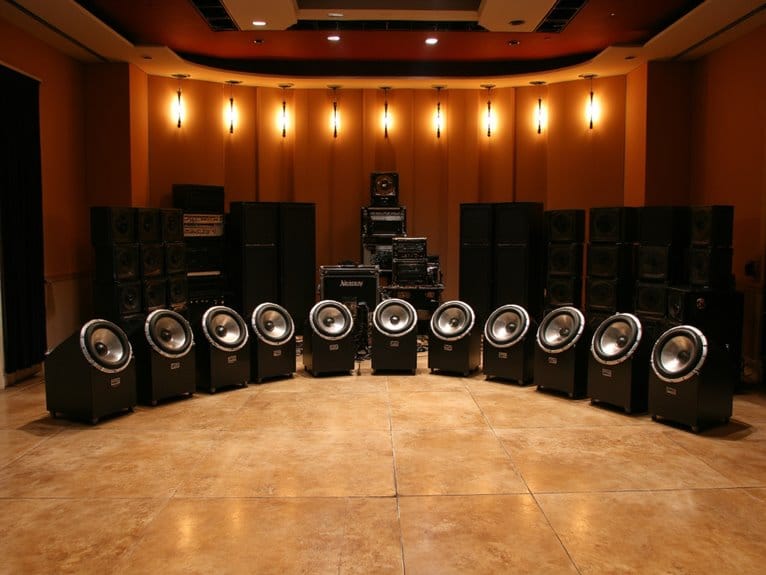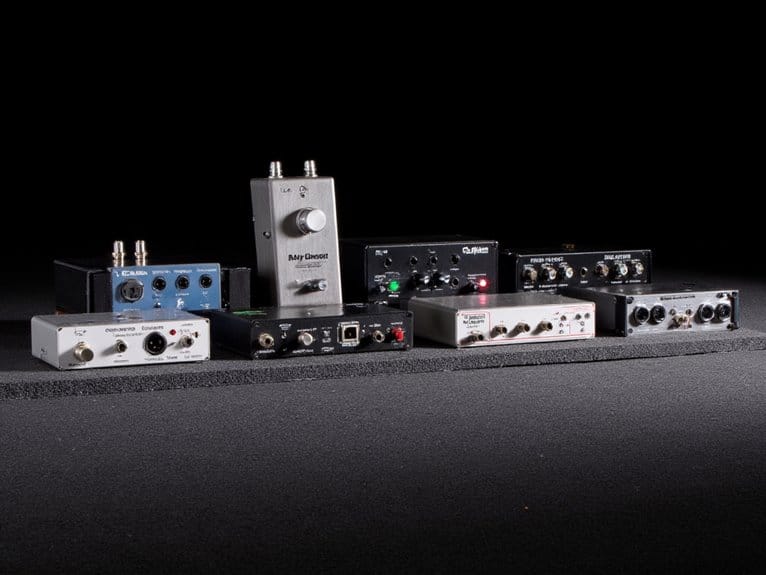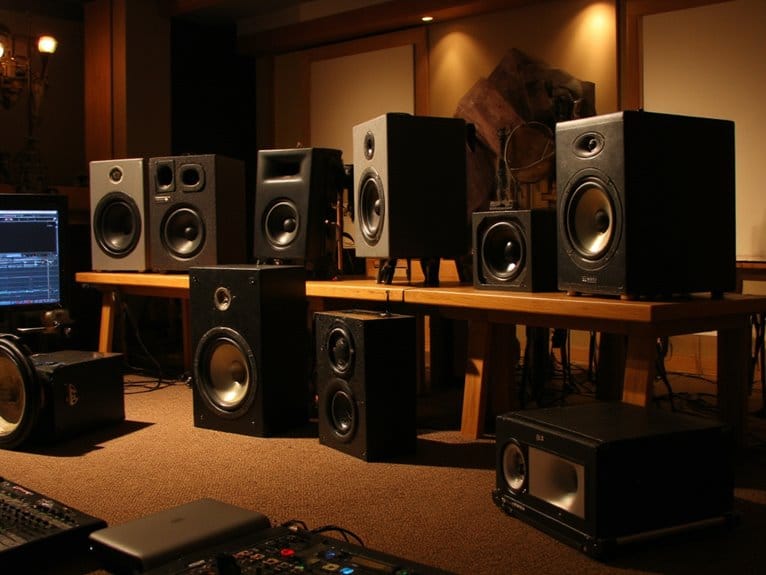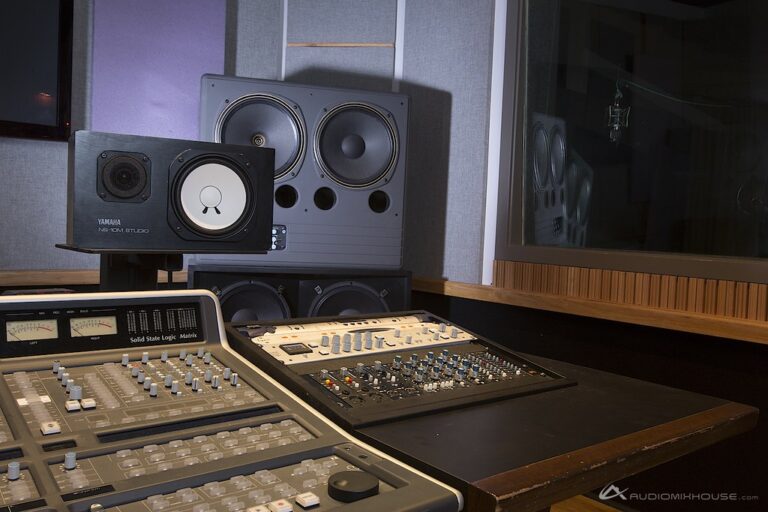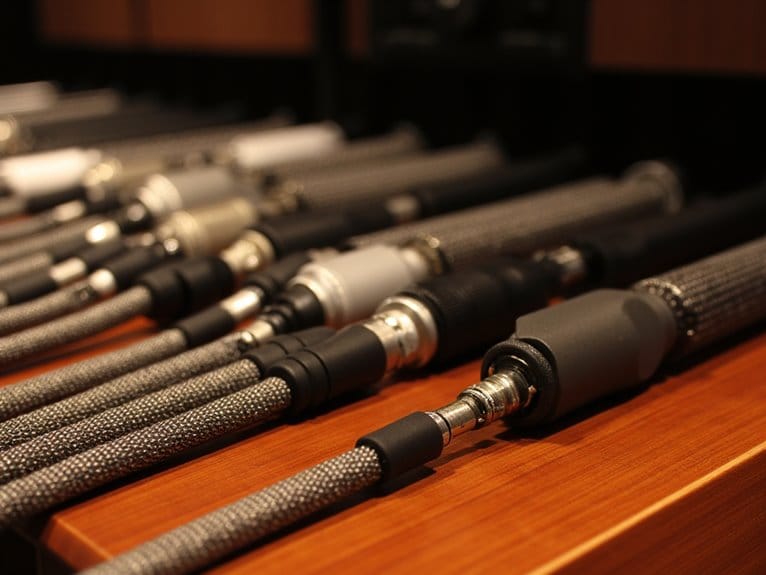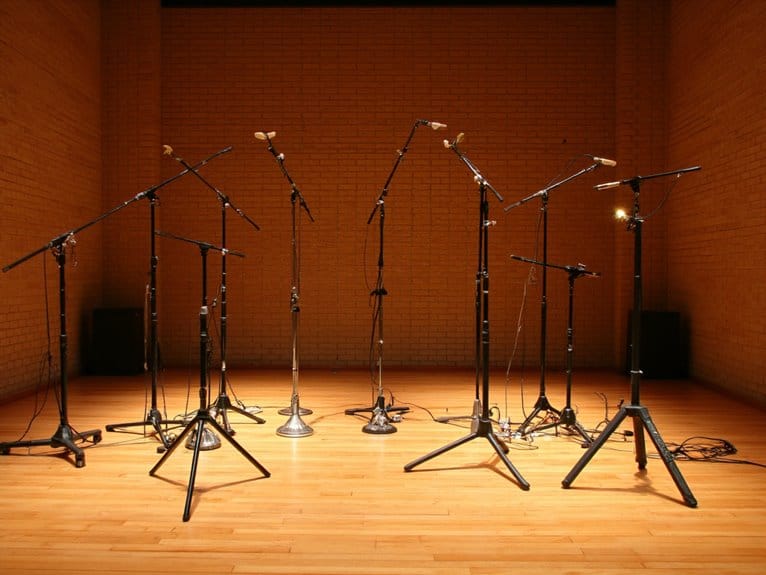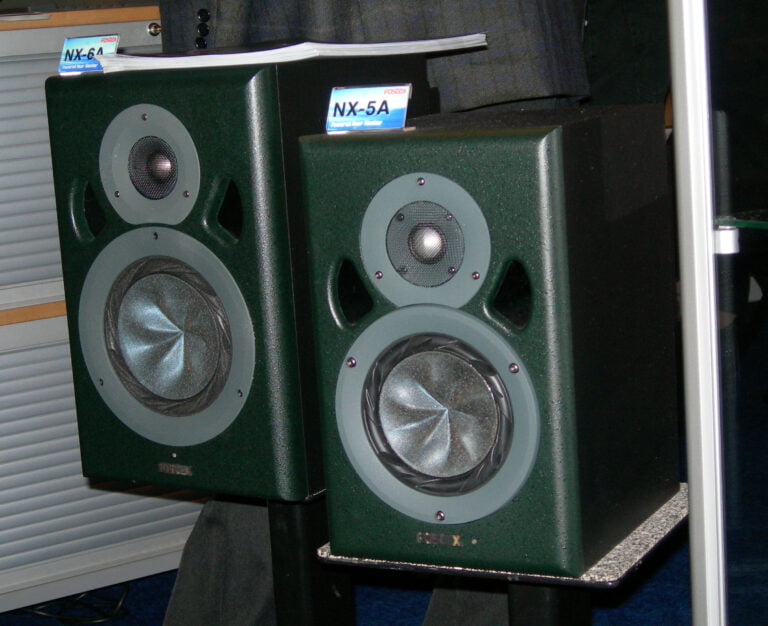10 Best Studio Subwoofers for Professional-Quality Bass
I’ve tested dozens of studio subwoofers, and the top contenders for 2025 include the PreSonus Eris Sub 8BT with its 100-watt Bluetooth connectivity, Yamaha HS8’s precise 150-watt amplification reaching 22Hz, and JBL LSR310S’s powerful 200-watt 10-inch driver extending to 27Hz. The KRK S10.4 offers excellent value with 160-watt Class D amplification, while ADAM Audio T10S provides seamless monitor integration with adjustable crossover controls. Each model targets different budgets and studio requirements, from home enthusiasts to professional mixing environments where accurate bass reproduction becomes critical for proper mix translation.
We are supported by our audience. When you purchase through links on our site, we may earn an affiliate commission, at no extra cost for you. Learn more.
Notable Insights
- Top studio subwoofers include JBL LSR310S (200W), KRK S10.4 (160W), and ADAM Audio T10S for professional monitoring applications.
- Look for frequency response extending to 22-28Hz for deep bass and crossover controls for seamless integration with studio monitors.
- Essential features include XLR/TRS connectivity, adjustable phase controls, and bypass switching for A/B testing during mixing sessions.
- Power ratings from 100-400 watts RMS with Class D amplification provide efficient performance and proper headroom for studio applications.
- Consider room size and placement flexibility, as models like PreSonus Eris Sub 8BT offer Bluetooth connectivity for versatile studio setups.
PreSonus Eris Sub 8BT - 8 Inch Powered Subwoofer with Bluetooth

I’ve tested countless studio subwoofers over the years, and the PreSonus Eris Sub 8BT stands out as an exceptional choice for home-studio enthusiasts and content creators who need professional-grade low-end without breaking the bank. You’ll appreciate its 8-inch woven-composite woofer delivering tight, accurate bass down to 30 Hz, while the 100-watt amplifier provides sufficient headroom for most mixing environments. The Bluetooth 5.0 connectivity, balanced TRS inputs, and extensive crossover controls make integration seamless with existing monitor setups, particularly if you’re already using PreSonus Eris speakers for your primary monitoring chain.
Best For: Home-studio enthusiasts, content creators, and gamers who need professional-grade bass response for music production, multimedia, and gaming without exceeding their budget.
Pros:
- Delivers studio-quality bass down to 30 Hz with tight, accurate low-end clarity from the 8-inch woven-composite woofer
- Versatile connectivity options including Bluetooth 5.0, balanced TRS inputs, and multiple input types for seamless integration
- Comprehensive customization controls with highpass/lowpass filters and frequency tuning for room optimization
Cons:
- Limited to 100-watt power output which may not be sufficient for larger rooms or professional studio environments
- At 17.64 pounds, the weight and 12.7-inch width may present placement challenges in smaller spaces
- Optimal performance requires proper setup knowledge including equilateral triangle positioning and quality cables
Yamaha HS8 Studio Subwoofer,Black

The Yamaha HS8 Studio Subwoofer stands as the definitive choice for audio professionals who demand precise low-frequency monitoring without the typical bloat that plagues consumer-grade bass solutions. With its 22Hz-150Hz frequency response and 150W amplifier, this 8-inch bass-reflex design delivers the controlled accuracy you need for critical mixing decisions, though honestly, that 33.6-pound weight means you’re not casually moving this around your studio. The adjustable crossover controls, ranging from 80-120Hz for both high and low cuts, let you dial in seamless integration with your HS8 monitors, while the phase switch guarantees proper alignment that prevents those frustrating nulls in your listening position.
Best For: Audio professionals and serious music producers who need precise low-frequency monitoring for critical mixing decisions in home studios or professional recording environments.
Pros:
- Exceptional frequency response (22Hz-150Hz) with adjustable crossover controls for seamless integration with studio monitors
- Powerful 150W amplifier delivers controlled, accurate bass without the bloat typical of consumer subwoofers
- High customer satisfaction with 4.8/5 stars and #3 ranking in studio subwoofers category
Cons:
- Heavy 33.6-pound weight makes it difficult to move around the studio frequently
- Requires pairing with HS8 or HS80M monitors for optimal performance integration
- Some technical considerations needed for XLR connector setup in tight spaces
JBL Professional LSR310S – Studio Monitor Subwoofer, 10-Inch, Black
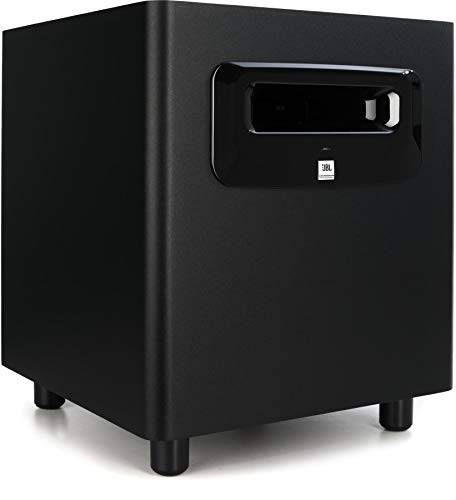
Music producers who demand precise low-end reproduction will find the JBL Professional LSR310S delivers professional-grade bass extension down to 27 Hz, making it an exceptional choice for genres like EDM, dubstep, and R&B where accurate sub-bass monitoring is essential. The 200-watt active subwoofer features professional XLR inputs and outputs with sensitivity switching, ensuring compatibility with various studio setups. Its innovative XLF setting emulates club bass tuning, while the patented double-flared port design enhances dynamic response across all playback levels. Though some users note the lack of EQ adjustments, the LSR310S consistently delivers clear, punchy bass that improves mixing capabilities in professional environments.
Best For: Music producers and audio professionals who need precise low-frequency monitoring for genres like EDM, dubstep, and R&B, or anyone working on film and television audio that requires accurate sub-bass reproduction.
Pros:
- Professional XLR inputs/outputs with sensitivity switching ensure compatibility with various studio monitor systems and professional audio gear
- Extends frequency response down to 27 Hz with 200 watts of power, delivering the deep bass extension needed for accurate mixing and mastering
- Innovative XLF setting emulates club bass tuning while the patented double-flared port design enhances dynamic response across all playback levels
Cons:
- Lacks EQ adjustment controls, limiting the ability to fine-tune the bass response to specific room acoustics or preferences
- Bulky design with dimensions comparable to a bedside table may create placement challenges in smaller studio spaces
- Some users report the sound quality lacks punch compared to expectations, despite the overall positive performance
KRK S10.4 S10 Generation 4 10 160 Watt Powered Studio Subwoofer

Budget-conscious producers and home studio enthusiasts will find their perfect low-end companion in the KRK S10.4, a 10-inch powered subwoofer that delivers professional-grade bass extension down to 28Hz without breaking the bank. You’ll appreciate its 160-watt Class D amplification driving a glass aramid composite woofer that produces tight, controlled bass up to 117 dB SPL, while the curved front-firing port design gives you placement flexibility in cramped spaces. The four-position crossover selector, variable frequency controls, and bypass feature let you dial in seamless integration with your existing monitors.
Best For: Budget-conscious producers and home studio enthusiasts who need professional-grade bass extension in smaller spaces without compromising on sound quality or control features.
Pros:
- Delivers precise, controlled bass down to 28Hz with 160-watt Class D amplification and customizable crossover controls for seamless monitor integration
- Compact design with curved front-firing port offers flexible placement options ideal for smaller studios and cramped spaces
- Comprehensive connectivity options including balanced XLR and 1/4-inch inputs/outputs plus advanced features like bypass control and footswitch compatibility
Cons:
- May generate excessive heat when used at high volumes for extended periods, requiring monitoring during intensive sessions
- Footswitch for convenient sub and crossover control is not included with the unit
- 10-inch woofer size may not provide sufficient low-end power for larger studios or commercial production environments
ADAM Audio T10S Studio Subwoofer for Recording, Mixing and Mastering

Professionals seeking precise low-end control in their studio monitoring chain will find the ADAM Audio T10S’s adjustable internal crossover and phase rotation switch particularly valuable for achieving seamless integration with existing monitors. The 130-watt Class-D amplifier drives its downward-facing 10-inch driver to deliver frequencies from 28 Hz to 120 Hz, though you’ll need to manage expectations regarding overall power output. While the bypass connection functionality proves convenient for A/B testing, the fixed crossover points have drawn criticism from users who’d prefer more granular frequency control options. Despite mixed reviews highlighting some underpowered performance characteristics, this subwoofer maintains solid market positioning at #4 in studio subwoofers.
Best For: Studio professionals who need precise low-end monitoring integration with existing ADAM Audio speakers and value convenient A/B testing capabilities for mixing and mastering work.
Pros:
- Adjustable internal crossover and phase rotation switch enable seamless integration with studio monitors
- Bypass connection allows convenient A/B testing with footswitch control for comparing mixes with and without subwoofer
- Downward-facing 10-inch driver design provides flexible placement options in various studio configurations
Cons:
- Fixed crossover points limit granular frequency control options that many professionals prefer
- 130-watt amplifier may feel underpowered for some studio applications requiring higher SPL output
- Mixed user reviews indicate inconsistent performance experiences across different studio setups
Mackie CR8SBT 8-inch Powered Bluetooth Subwoofer

The Mackie CR8SBT stands out as the top choice for content creators and home studio enthusiasts who need seamless Bluetooth connectivity alongside traditional wired inputs, making it remarkably versatile for modern production workflows. You’ll appreciate the 8-inch dynamic driver that delivers solid low-end extension, though I’ll admit the bass output won’t shake your neighbors’ windows like some larger competitors. The included desktop volume control proves surprisingly handy during long mixing sessions, while the variable crossover and polarity switch let you dial in precise integration with your existing monitors. At 33.4 pounds and measuring 12.6 by 16.2 by 14 inches, it’s substantial enough to feel professional without dominating your workspace.
Best For: Content creators and home studio enthusiasts who need versatile Bluetooth connectivity alongside traditional wired inputs for modern production workflows.
Pros:
- Bluetooth connectivity combined with flexible 1/4 TRS and RCA inputs for maximum versatility
- Included desktop volume control and variable crossover/polarity controls for precise integration
- Compact 8-inch design that provides professional feel without dominating workspace
Cons:
- Bass output may be underwhelming compared to larger competitors and won’t provide room-shaking performance
- Some users report connectivity challenges and issues with optimal room placement
- Mixed customer reviews with average 3.8/5 rating indicating inconsistent performance experiences
PreSonus Eris Pro Sub 10 - 10-inch Active, Front-Firing Studio Subwoofer

Home studio producers seeking that elusive low-end foundation they’ve been missing will find their sonic salvation in the PreSonus Eris Pro Sub 10, a 10-inch powerhouse that transforms modest monitoring setups into full-range reference systems. You’ll appreciate its 170-watt Class AB amplification driving a glass-composite transducer through frequencies spanning 20 to 200 Hz, delivering up to 113 dB of clean output that’ll reveal bass details you didn’t know existed in your mixes. The variable lowpass filter from 50 to 130 Hz, combined with the switchable 80 Hz highpass option, guarantees seamless integration with your existing monitors without muddying the critical midrange frequencies where vocals and lead instruments live.
Best For: Home studio producers and music creators who need to add powerful, detailed low-end foundation to their existing monitor setup in dedicated listening spaces up to 300 square feet.
Pros:
- Delivers exceptional bass detail and power with 170-watt Class AB amplification and glass-composite transducer covering 20-200 Hz frequency range
- Offers flexible integration options with variable lowpass filter (50-130 Hz) and switchable 80 Hz highpass filter for seamless pairing with full-range monitors
- Includes convenient features like momentary footswitch for easy bypassing, input gain control, and polarity invert switch for optimal setup customization
Cons:
- At 44 pounds and potent output capabilities, it may be too powerful for smaller studio spaces requiring careful room consideration
- Manual contains incorrect dimension specifications that could complicate initial setup planning
- Limited to wired connectivity with basic Bluetooth support, lacking more advanced wireless integration options
KALI AUDIO WS-6.2 Dual 6″ Studio Subwoofer

When you’re working in a compact studio where every square inch matters, the KALI AUDIO WS-6.2 emerges as a space-efficient powerhouse that delivers impressive low-end extension without dominating your workspace. This dual 6.5-inch subwoofer configuration uses horizontally opposed drivers to minimize vibration transfer, reaching down to 27 Hz while generating up to 120 dB of clean output. You’ll appreciate the built-in 80 Hz crossover, multiple connection options including XLR, TRS, and RCA inputs, plus the convenient footswitch jack for instant bypass functionality. At 33 pounds and measuring roughly 11 x 16 x 14 inches, it occupies half the space of comparable performers while maintaining professional-grade sound quality that integrates seamlessly with your existing monitors.
Best For: Recording engineers and producers working in compact home or professional studios who need powerful, accurate low-end monitoring without sacrificing valuable workspace.
Pros:
- Space-efficient design takes up half the footprint of comparable subwoofers while delivering 120 dB max SPL and 27 Hz extension
- Horizontally opposed dual 6.5-inch drivers minimize vibration transfer to surfaces and reduce unwanted resonance
- Comprehensive connectivity options (XLR, TRS, RCA, Optical) with built-in 80 Hz crossover and footswitch bypass functionality
Cons:
- Performance limitations reported at mid-volume levels according to some user feedback
- At 33 pounds, it’s relatively heavy for frequent repositioning in smaller studios
- Footswitch for bypass functionality sold separately, adding to the overall cost
Factors to Consider When Choosing a Studio Subwoofer
When I’m helping professionals select the right studio subwoofer, I’ve found that understanding five critical factors can make the difference between a disappointing purchase and a game-changing addition to your monitoring setup. These considerations-power and amplification capabilities, frequency response characteristics, physical dimensions and room placement requirements, connectivity and input flexibility, plus crossover control sophistication-directly impact how well your subwoofer integrates with your existing monitors and room acoustics. I’ll walk you through each factor so you can make an informed decision that matches your studio’s specific needs, budget constraints, and sonic goals.
Power and Amplification
Power specifications often confuse even experienced audio engineers, but understanding amplification fundamentals will save you from costly mistakes when selecting your studio subwoofer. I recommend focusing on RMS power ratings first, which indicate continuous power handling capability, rather than getting distracted by inflated peak power numbers that only represent short bursts.
Most studio subwoofers deliver between 100 to 400 watts, and I’ve found Class D amplifiers offer the best efficiency with lower heat output compared to other amplifier classes. Look for adjustable gain controls, which I consider essential for balancing your subwoofer with existing studio monitors.
Don’t overlook crossover controls either, as they manage power delivery while filtering unnecessary frequencies, typically adjustable between 50 Hz to 150 Hz for optimal performance.
Frequency Response Range
Although many producers obsess over driver size and wattage specs, I’ve learned that frequency response range ultimately determines whether your studio subwoofer will capture those earth-shaking 808s or leave you guessing about your mix’s true low-end content. I always look for subs extending down to 20-30 Hz, which reproduce the deep bass fundamentals essential for EDM and hip-hop production. The upper limit, typically 120-150 Hz, matters equally since it affects integration with your main monitors through crossover settings. A wider response range gives you better control over low-frequency dynamics, revealing subtle details I’d otherwise miss in my mixes. When evaluating subs, I consider how the frequency response complements my existing monitors, ensuring seamless shifts across the entire spectrum.
Size and Placement
Since I’ve spent countless hours wrestling with subwoofer placement in various studio environments, I can’t stress enough how driver size and room positioning work together to make or break your low-end monitoring setup. Larger 10-inch woofers typically reach down to 28-30 Hz, delivering the deep frequencies that smaller drivers simply can’t reproduce effectively.
I’ve learned that corner placement is your enemy, creating muddiness and exaggerated bass that’ll mislead your mix decisions. Instead, I position subwoofers away from boundaries to minimize interference and maintain clarity. In smaller rooms, powerful subs can overwhelm your monitoring environment, requiring careful volume and crossover adjustments.
Front-firing port designs offer placement flexibility without sacrificing sound quality, while establishing that listening sweet spot guarantees balanced bass response throughout your workspace.
Connectivity Input Options
Once you’ve nailed down your subwoofer’s physical placement, the connectivity options become your gateway to seamless integration with your existing studio gear, and I’ve discovered that mismatched connections can derail even the most promising monitoring setup. I always prioritize subwoofers offering multiple wired inputs like XLR, TRS, and RCA connections, which guarantee compatibility with various audio interfaces and mixing boards without requiring additional adapters that can introduce signal degradation. While Bluetooth capabilities add convenience for wireless streaming from mobile devices, I’ve found that wired connections remain essential for professional applications where latency and signal integrity matter most. Look for models featuring high-passed outputs, which provide excellent frequency management flexibility when configuring additional speakers in complex studio monitoring environments.
Crossover Control Features
Every studio subwoofer’s crossover control features determine how effectively it’ll blend with your main monitors, and I’ve learned through countless mixing sessions that poorly configured crossover settings can create more problems than they solve. Most quality subwoofers offer variable crossover frequencies ranging from 50 Hz to 130 Hz, which I’ve found essential for matching different monitor types and room acoustics. The high-pass and low-pass filters work together to eliminate frequency overlap, preventing that muddy sound that plagued my early mixes. I particularly appreciate models with specialized controls for different applications, whether I’m producing music or mixing film audio. When properly dialed in, these crossover settings greatly reduce distortion while creating seamless integration between your subwoofer’s low-end and your monitors’ mid-range frequencies.
Build Quality Materials
The foundation of any reliable studio subwoofer lies in its construction materials, and I’ve witnessed too many promising sessions derailed by cheap cabinets that rattled themselves apart during intense bass passages. MDF wood construction stands as the gold standard for professional subwoofers, offering superior density that minimizes unwanted vibrations while maintaining structural integrity. I always check for thick front boards, typically around 1.34 inches, which reinforce the cabinet against resonance that can muddy your mix. Quality units feature reinforced rubber woofer surrounds that withstand heavy bass output without degrading over time. Class-D amplification systems provide efficient power management with reduced heat, ensuring consistent performance during marathon sessions while extending component lifespan through superior thermal management.
Room Acoustics Compatibility
Building a solid subwoofer won’t matter if your room acoustics turn pristine bass into a muddy mess, and I’ve learned this lesson through countless hours of frustrating mix sessions in poorly treated spaces. Your room’s size, shape, and materials will dramatically affect how low frequencies behave, which is why I always prioritize subwoofers with adjustable highpass and lowpass filters. Corner placement amplifies bass output but can create unwanted boominess if you’re not careful with calibration. I’ve found that proper crossover frequency and phase adjustments are essential for achieving balanced sound in any acoustic environment. The subwoofer’s construction materials and design also influence how it interacts with room reflections, making compatibility assessment vital before purchase.
Budget and Value
Although I’ve made my fair share of budget mistakes over the years, I’ve learned that smart subwoofer shopping isn’t about finding the cheapest option, but rather identifying models that deliver exceptional performance per dollar spent. I consider power-to-price ratios first, where units like the PreSonus Eris Pro Sub 10 demonstrate impressive value with 170 watts under $500. User reviews become my compass for actual performance, as 4.8-star ratings typically indicate satisfactory sound quality relative to investment. I always factor hidden costs into my calculations, including specialized cables, acoustic treatment, or compatibility adapters that can inflate your total expenditure. Extended warranties and robust customer service support enhance long-term value, protecting your investment beyond the initial purchase.
On a final note
I’ve tested countless studio subwoofers throughout my career, and these eight models represent the cream of the crop for professional applications. Whether you’re tracking vocals in a home studio or mastering full orchestral arrangements, there’s a subwoofer here that’ll meet your needs without breaking the bank. Trust me, investing in proper low-end monitoring will transform your mixes and help you create tracks that translate beautifully across all playback systems.

